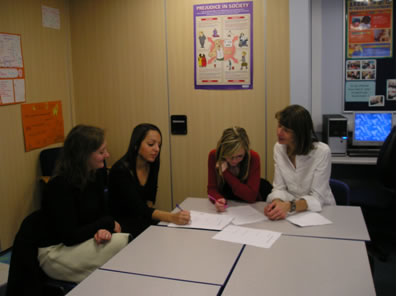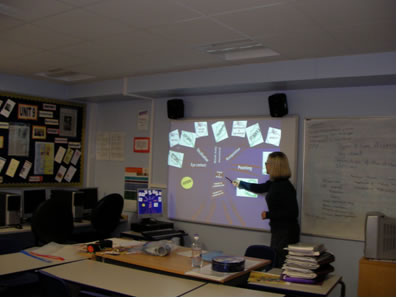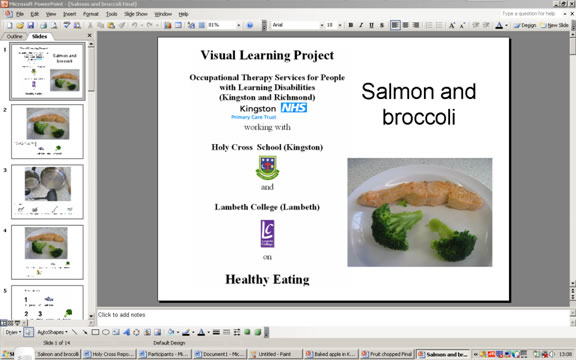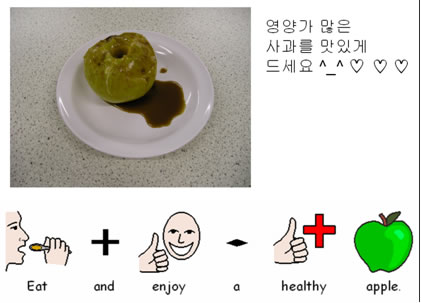Resources | Community Cohesion | Cross-curricular | Case Studies | Seminar Materials | Links Archive
Community Cohesion 1: Healthy Eating Project
Visual Learning Healthy Eating Project
 Kingston NHS Primary Care Trust, Kingston and Richmond
Kingston NHS Primary Care Trust, Kingston and Richmond
Occupational Therapy Services for People with Learning Difficulties
Holy Cross School, Kingston
Lambeth College, Lambeth
Report on the Visual Learning Project: Healthy Eating
Lorian Mead, NHS
Lloyd Mead, FE
Lawrence Williams, SSAT
Aims and Objectives
General aim
This Visual Learning Project aims to use a range of ICT tools to draw together
several different groups within the local community, in a series of practical
activities through which the participants can share and develop their different
knowledge and expertise.
 Occupational Therapy Group (Kingston Primary Care Trust)
Occupational Therapy Group (Kingston Primary Care Trust)
Aims
- To support processes by which people with learning disabilities are active and equal participants in the project
- To link with the wider community, sharing knowledge and understanding of the work of Occupational Therapists (OTs)
- To be involved in the development of accessible resources, (web- and paper-based) that support people with learning disabilities in leading healthy lifestyles
Objectives
- To develop resources (web and paper-based) that can be used by OTs and their clients, in the development of Healthy Eating skills. These will be in a range of visual learning formats, that meet the needs of adults with learning disabilities
- To support the work of local schools and colleges through a series of educational visits, providing consultation about activity analysis, healthy eating, and the impact of learning disabilities on occupational participation
- To use the Healthy Eating resources in the work of OTs
- To contribute to written final report of the Project, which will be of use to other groups within the NHS, and beyond
 Holy Cross School (Kingston, Surrey)
Holy Cross School (Kingston, Surrey)
Aims
- To learn about the work of Occupational Therapists and the role they play in the community
- To develop AS and A2 Level knowledge and skills in Healthy Eating, communication skills, and visual learning
- To widen the knowledge base of visual learning, and to support the NAACE Visual Learning Project through the publication of relevant aspects on the MirandaNet web site
Objectives
- To create a series of recipes in different visual learning formats
- To create a set of web pages to publish these recipes
- To contribute student evaluations to the final written report of the project
 Lambeth College
Lambeth College
Aims
- For Lambeth College students to collaborate, as consultants, with students and teachers in another educational institution, and to share their experiences of learning disabilities
- To increase their knowledge about healthy eating
Objectives
- To understand their role in the process
- To pilot the draft visual learning resources, by trialling the recipes created
- To provide constructive feedback on the visual learning resources, and to contribute student evaluations to the final written report
Project Development
Occupational Therapists (OTs) in Kingston found themselves in need of support materials in healthy eating skills, for people with learning disabilities. Accordingly, Lorian Mead, Head Occupational Therapist for the Kingston NHS Primary Care Trust, approached Lawrence Williams, at The Holy Cross School, to set up a series of meetings through which the aims of the three groups listed above might be met.
 The first visits to the school, by Lorian Mead (left of picture) and her
colleague, Jackie Williams, centred on sharing the work of OTs with the Year
12 AS Health and Social Care students. These visits supported the work of
the Holy Cross AS students, as well as widening the knowledge of the OT group
regarding school Health and Social Care course requirements, as explained
here by Nicki Murphy (right of picture).
The first visits to the school, by Lorian Mead (left of picture) and her
colleague, Jackie Williams, centred on sharing the work of OTs with the Year
12 AS Health and Social Care students. These visits supported the work of
the Holy Cross AS students, as well as widening the knowledge of the OT group
regarding school Health and Social Care course requirements, as explained
here by Nicki Murphy (right of picture).
Jackie Williams, OT, writes, "Overall I felt that both of the sessions had gone very well. The students appeared interested and motivated, and I could see the level of engagement improve as the session developed, particularly when interactive activities were being used.
I feel that the information shared on what the role of OT was helped by adding in some ‘real life’ examples of my practice.
 The activities that were used really helped to illustrate to the student
groups, and the complexities associated with understanding communication.
Students appeared to begin to understand the importance of being able to
recognise the importance of identifying the communication needs of individuals
with learning disabilities, to be able to adapt communication approaches
in a flexible and effective way, to suit these needs. Through the use of
a case study activity, the students demonstrated that they had an understanding
of the roles of some of the professionals that are based within a multi disciplinary
community team."
The activities that were used really helped to illustrate to the student
groups, and the complexities associated with understanding communication.
Students appeared to begin to understand the importance of being able to
recognise the importance of identifying the communication needs of individuals
with learning disabilities, to be able to adapt communication approaches
in a flexible and effective way, to suit these needs. Through the use of
a case study activity, the students demonstrated that they had an understanding
of the roles of some of the professionals that are based within a multi disciplinary
community team."
The Consultants
As another part of the learning process for teachers and students at Holy
Cross, Lloyd Mead, from Lambeth College, brought a group of his students
to act as Consultants on the project. They spent a valuable morning at Holy
Cross, working on the project alongside the AS Level group.
The information and expertise both in learning disabilities, and healthy eating, gained from the OTs and from the Lambeth College students was then passed down to a group of Year 9 students, who stayed behind on several Mondays after school, to work on the project. Their task was to cook a series of healthy meals, and to record the whole process with a digital camera, so that the food recipes would be in an accessible format for people with learning disabilities. These eight recipes, worked out in consultation with Jackie Williams, were for Tomato Soup, Spaghetti, Baked Potato, Cheese Salad, Chicken Curry, Salmon and Broccoli, Baked Apple, and Fruit Salad.
Philippa writes, "Our Year 9 group made the food and photographed each stage of the process. It worked well, and we soon got into the hang of making sure nothing else was in the photo shot.
We worked well as a team, and I thoroughly enjoyed finding the Tomato Soup recipe, and then actually cooking the food. I even tried cooking some of the things at home. The step by step way that we made the food meant that I memorised the recipe without even realising it, so that if a person asked me for a recipe for Spaghetti Bolognese, for example, I would be able to give them the recipe out of the top of my head!
Overall, the project was wonderful, and a lot of fun to do, not only as it going to be used by other people, but because it taught me, and the others who did it, how to cook well, and how to make healthy meals that anyone can enjoy.
Thank you!"
Following the Year 9 cooking and photography work, the images of the cooking process were added into PowerPoint files, each file containing one of the recipes listed above.

Then the project moved down, again, this time into Year 8, where two students added some of the Widgit text and symbols. This was not simple, as the students had to write the text in Widget, take a screen shot of the text and images, drop the screen shot into Paint, and edit it before importing it into PowerPoint.
Next, some of these PowerPoint files were sent electronically to Lambeth College, where Lloyd Mead’s students tested out the accessibility and accuracy of the presentations. Adjustments and improvements were then sent back to Holy Cross, to be incorporated into the revised recipe versions.
Next, the completed files were given to two Year 7 Korean students, who, with the help of their parents, translated the recipes into Korean. They did this by adding Korean text files next to the English language Widgit images:

(NB the Widgit images on this slide are Copyright © Widgit Software)
Year 7 students also provided an additional feature to the project, by creating a series of four safety logos, which were added into the PowerPoint at appropriate moments. Two examples:


ICT tools used
- Email was used for regular communication between the participants
- PowerPoint was used to create a framework for the recipes
- Digital cameras were used to photograph the cookery images
- Widgit software was used to write the illustrated text
- Paint was used to edit the Widgit images, and to create the Warning Logos
- On-line Korean dictionaries were used to assist translation
- CD Roms were burnt to house the shorter version of the project (File size 0.7 GB)
- DVDs were burnt to house the full project, including the Korean files and Reports (4.7 GB)
Print outs
To indicate to potential users how the files on the CD Rom and the DVD could
be used, a plastic bound printed version of one of the recipes was printed
out.
Use of the materials
Almost as soon as they were printed out, copies of the recipes were used
by Lambeth students, Holy Cross teachers (SEN Department) and school students,
and student teachers.
Future plans
At Holy Cross, we plan to develop the science aspects of the work through
detailed analysis of the nutritional content of the recipes. This information
will be added into the second phase of this visual learning project.
Participants
Lorian Mead, B.Sc. Hons.
Head Occupational Therapist
Learning Disabilities Services in Richmond and Kingston
Kingston Primary Care Trust
22 Hollyfield Road
Surbiton
Surrey
KT5 9AL
020 8786 6000
Jackie Williams, B.A. Hons.
Occupational Therapy Technical Instructor
Learning Disabilities Services in Richmond and Kingston
Kingston Primary Care Trust
22 Hollyfield Road
Surbiton
Surrey
KT5 9AL
020 8786 6000
Lawrence Williams MA, MBCS
Head of Creative Development
Holy Cross School
Sandal Road
New Malden
Surrey
KT3 5ANs
Tel: 020 8395 4225
Nicki Murphy MA
Head of Health and Social Care
Holy Cross School
Sandal Road
New Malden
Surrey
KT3 5AN
Tel: 020 8395 4225
Lloyd Mead BA Hons.
Tutor 16-18 Preparation for Vocational Skills
Lambeth College
45 Clapham Common Southside
Clapham
London SW4 9 BL
Tel: 020 7501 5107
Student Participation
Students from Lambeth College and The Holy Cross School:
Year 12 AS Health and Social Care group
Year 9 Cooking and Photography Philippa Moseley, Sarah Choi,
Katie Holland, Klara Choromanska, Ashleigh Donnley
Year 9 Cooking and Photography report Philippa Moseley, Sarah Choi
Year 8 Working with Widgit software Cherry Paice, Caitriona Lowry
Year 7 Translation into Korean Ye In Kim, Dahye Park
Year 7 Warning Logos Hannah Rogers , Angela Condino
[Back]

